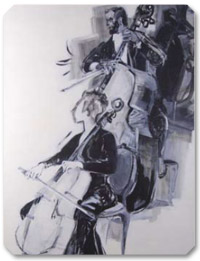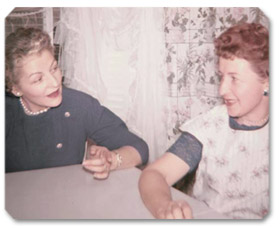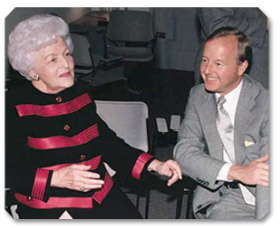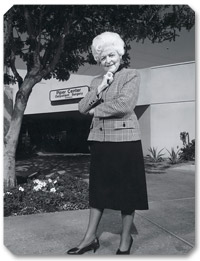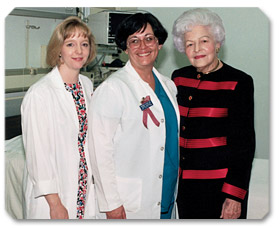|
CHAPTER FIVE Unquestionably, music comforted Virginia and brought immense joy. She and her sister, Carol, both enjoyed attending the Phoenix Symphony, sitting in their box, the first on the left. It was from this box that Virginia would wave graciously to the conductor and the musicians who sincerely appreciated her million-dollar challenge grant for community members to match in order to double her contribution for the Now for the '90s Phoenix Symphony Stabilization Campaign. Her gift, according to Howard McCrady, then President and CEO of the Phoenix Symphony, was "the largest in [their] history." Virginia, in a letter dated February 12, 1990, wrote: "I have gratefully observed that this so-called 'leadership grant' has, as predicted, prompted others to follow suit!" During Virginia's lifetime, she also funded refurbishments of the Scottsdale Center for the Performing Arts theater and of the Phoenix Boys Choir Concert Hall. For nearly twenty-five years, Virginia faithfully contributed to the Arizona Kidney Foundation to support their Annual Authors' Luncheon, an event that Erma Bombeck founded. Virginia's front and center table was a visible testament to her interest and involvement in this cause. Virginia respected and admired Erma and Bill Bombeck. When Bill called to request one million dollars for the new office building of the American Red Cross, she immediately said yes. More than anything, Virginia loved seeing people progress. Each generation, in her view, should have greater opportunities for a better life. Fundamentally, she saw herself as a servant to civilization's progress. Her great ability to empathize with others across class, racial, and ethnic lines-her ability to embrace all people and to see each and every one as an expression of the divine- motivated her. While Virginia was lucky enough to have nearly a half billion dollars to effect change, she was smart enough and compassionate enough to want to make the world better-not in the abstract but in concrete ways. Her giving was always strategic and integrated. Perhaps most importantly, Virginia understood how healthcare was integral for a healthy society. Her sustained support of Scottsdale Memorial Hospital (now Scottsdale Healthcare) was invaluable to a growing community. When north Scottsdale was a rural landscape, more desert than family plots, Virginia nonetheless foresaw the need for healthcare services in a community not yet fully populated. Early in the 1970s, she and Ken encouraged Motorola to invest a quarter of a million dollars in the growing hospital. Upon Ken's death in 1975, she invested in the creation of Scottsdale Memorial's Kenneth M. Piper Family Health Center. During Virginia's lifetime and because of her sustained giving, the health center expanded from its original 8,700 square feet to become, eventually, the comprehensive 32,000-square-foot Piper Outpatient Surgical Center. Virginia was among the early advocates for better, cutting-edge "whole" patient care,but again, inclusiveness was important to Virginia. Whether young or old, rich or poor, Virginia never forgot the diversity of her community. When Virginia was approached for a major gift to support adding a second floor for overnight outpatient services for the Piper Outpatient Surgical Center, she immediately asked about pediatric surgery. Assured the center would provide childhood-to-senior surgical care, she contributed to the building facility fund. Virginia's major gifts (particularly in healthcare) received much publicity. Virginia only accepted such attention because she shrewdly recognized how publicity generated community awareness and "challenged" others to support worthy causes. Virginia always focused on impact and people. Time and again, she spoke with nurses and doctors, always asking, "Do you have what you need to do your job well?" Virginia also became interested and involved in Esperanza, a nonprofit international health organization based in Phoenix and directed by a Franciscan brother and general surgeon, William Dolan, MD, who organized volunteer doctors and surgeons to provide medical care in the Amazon. Virginia was thrilled to assist, recognizing that in many areas throughout the world, basic healthcare was nonexistent. Combating childhood intestinal parasites, polio, infections, and starvation in the Amazon paralleled Virginia's efforts for supporting impoverished families in Arizona. Until her death in 1999, Virginia deepened her charitable focus on religious life and the impact of religion in society. She gave funds, in Phoenix, to both Xavier College Preparatory and Brophy College Preparatory, again, integrating her charitable foci. Faith, education, and adolescent well-being were all advanced by her commitment to these Catholic schools. On June 24, 1993, at Xavier College Preparatory, the Virginia G. Piper Center for Science and Computer Studies opened. Virginia was the major contributor to this effort, and in the foyer, her sister Carol's painting of a "colorful, floral desert scene" graces the wall. Virginia also significantly supported Brophy College Preparatory scholarships and never failed to donate auction items for fundraising. Seeing young people thrive educationally was a passion for Virginia. |
|
| About the Author l Pipertrust.org | |








